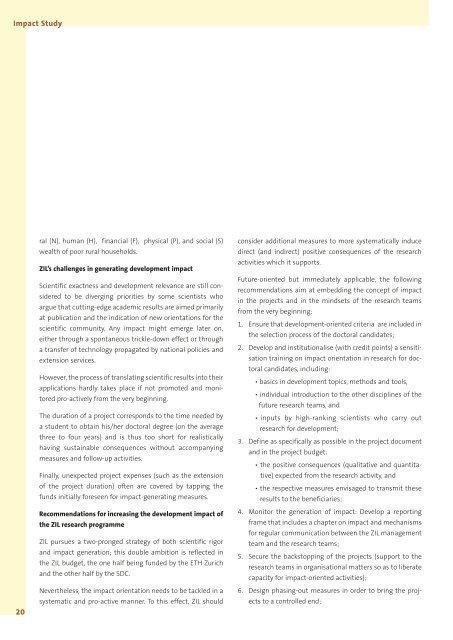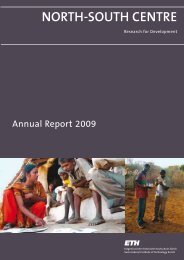Annual Report 2006/07 - ETH - North-South Centre North-South ...
Annual Report 2006/07 - ETH - North-South Centre North-South ...
Annual Report 2006/07 - ETH - North-South Centre North-South ...
Create successful ePaper yourself
Turn your PDF publications into a flip-book with our unique Google optimized e-Paper software.
Impact Study20ral (N), human (H), financial (F), physical (P), and social (S)wealth of poor rural households.ZIL’s challenges in generating development impactScientific exactness and development relevance are still consideredto be diverging priorities by some scientists whoargue that cutting-edge academic results are aimed primarilyat publication and the indication of new orientations for thescientific community. Any impact might emerge later on,either through a spontaneous trickle-down effect or througha transfer of technology propagated by national policies andextension services.However, the process of translating scientific results into theirapplications hardly takes place if not promoted and monitoredpro-actively from the very beginning.The duration of a project corresponds to the time needed bya student to obtain his/her doctoral degree (on the averagethree to four years) and is thus too short for realisticallyhaving sustainable consequences without accompanyingmeasures and follow-up activities.Finally, unexpected project expenses (such as the extensionof the project duration) often are covered by tapping thefunds initially foreseen for impact-generating measures.Recommendations for increasing the development impact ofthe ZIL research programmeZIL pursues a two-pronged strategy of both scientific rigorand impact generation; this double ambition is reflected inthe ZIL budget, the one half being funded by the <strong>ETH</strong> Zurichand the other half by the SDC.Nevertheless, the impact orientation needs to be tackled in asystematic and pro-active manner. To this effect, ZIL shouldconsider additional measures to more systematically inducedirect (and indirect) positive consequences of the researchactivities which it supports.Future-oriented but immediately applicable, the followingrecommendations aim at embedding the concept of impactin the projects and in the mindsets of the research teamsfrom the very beginning:1. Ensure that development-oriented criteria are included inthe selection process of the doctoral candidates;2. Develop and institutionalise (with credit points) a sensitisationtraining on impact orientation in research for doctoralcandidates, including:• basics in development topics, methods and tools,• individual introduction to the other disciplines of thefuture research teams, and• inputs by high-ranking scientists who carry outresearch for development;3. Define as specifically as possible in the project documentand in the project budget:• the positive consequences (qualitative and quantitative)expected from the research activity, and• the respective measures envisaged to transmit theseresults to the beneficiaries;4. Monitor the generation of impact: Develop a reportingframe that includes a chapter on impact and mechanismsfor regular communication between the ZIL managementteam and the research teams;5. Secure the backstopping of the projects (support to theresearch teams in organisational matters so as to liberatecapacity for impact-oriented activities);6. Design phasing-out measures in order to bring the projectsto a controlled end;
















